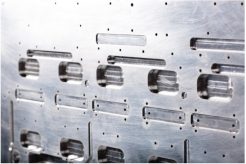Introduction
Mobile communications, digital TV and Radio, Defense, Medical applications are all related to the signal processing market. The ever-increasing need for bandwidth and speed is driving the use of higher-powered electronics in the telecommunication sector in outdoor base stations, cell towers, central servers, and satellites. High power electronics require a customer-dedicated thermal management solution consisting of very efficient air-cooled heatsinks or actively cooled cold plates.
Priatherm can solve it with:
- Design flexibility
- Outstanding performances
- Application made solutions
- High reliability
Application field
Broadcasting players need to develop solutions for a market that is continuously under evolution. Technologies for home entertainment, new TV services, sophisticated equipment for the high definition of the visual and audio signals are making progress daily.
There are many different electronic devices inside the PCB and the racks for digital signal transmissions; the vast majority of these components are small and develop heat during operation. The need for efficient power heat removal, especially in areas with a very high power density, is the problem to solve.
Very often a broadcasting application is composed of several racks working in parallel, positioned inside a closed cabinet: liquid cooling is the best choice because it is possible to remove hundreds of Watts with a good design of channels in parallel, crossed by water and antifreeze additive, in a compact space.
The service elements of the hydraulic circuit, such as pump, expansion tank, air-liquid exchanger, are positioned outside the cabinet.
The challenge
The design had to solve the problem taking into account several critical parameters for the customer:
- Use as coolant fluid of a mixture of water + ethylene glycol (min. 25% in volume, but up to 50% to satisfy the lowest permissible ambient temperature specified for the place of installation).
- Flow rate: average 12 l/min (but a safer calculation must consider a down rate until 8 l/min).
- Liquid solutions are generally used for amplifiers with overall electrical power greater than 25 kW; the thermal power to be dissipated for each rack (and therefore for each LCP) can even exceed 2 kW. In this case, the LCP was dimensioned for dissipation of 1,8 kW.
- Power transistors have the maximum efficiency below a temperature of 100 °C, but they can operate up to maximum temperatures of 150 °C on the case.
- T in of the fluid was specified 30 °C.
- Available space was the standard 19” (inches) rack. LCP was less than 17 ¾” wide (approx. 451 mm) and less than 24″ deep (approx. 610 mm).
- The significant power density of the transistors (footprint 3 – 3,5 cm2), which in certain cases can reach 200-250 W/cm2.
Solution
RF cooling by water allows engineers to get 3 main advantages:
- Smaller size of the amplifier
- Reduced heat load on the amplifier room (not demanding HVAC requirements)
- Reduced noise (No fans)
The internal design of the cold plate has been deeply studied with CFD analysis software. Cooling channels had to pass under all critical heat sources to reduce the overtemperature of the components: efficiency and lifetime of Electronics will increase providing the customer and the end-user with significant advantages. Flow rate, fluid speed, pressure drop, the path of the circuit (parallel Vs series, short cuts, proper curves, collectors, etc.) were important parameters to consider and optimize.
Manufacturing limitations and safety rules have been also kept in mind in the design, to control costs and secure correct sealing. Regarding this, all Cold Plates must be tested at overpressure to validate the quality of the joint and ensure the customer that no liquid will drop on the electronic circuits by mistake.


Top challenges
- Very low thermal resistance requested
- High power density under some small components
- Pressure drop of the coolant to be kept as low as possible
- Reliability
Ask our Experts
Error: Contact form not found.